#spanish caravaggio
Text
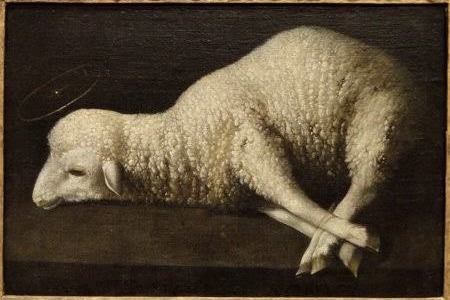
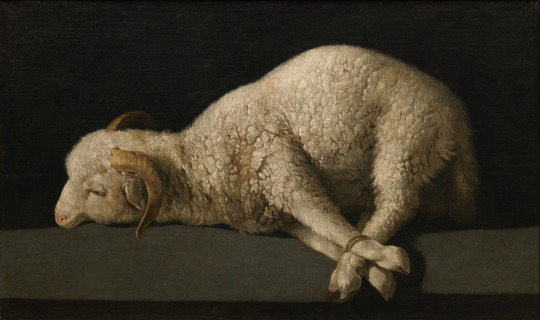
agnus dei, francisco de zurbarán
#agnus dei#lamb of god#francisco de zurbarán#spanish caravaggio#baroque art#17th century art#zurbarán
4K notes
·
View notes
Text
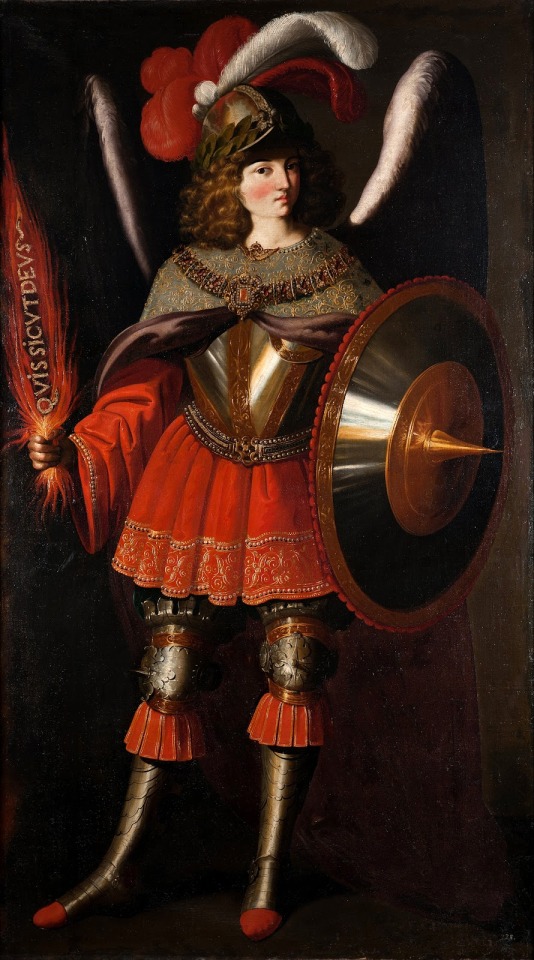
Francisco De Zurbarán | The Spanish Caravaggio
3 notes
·
View notes
Text
Nothing more sacred to me than a trans man and their cissy girlfriend
#ive been obssessed w this dynamic recently#caravaggio y lisa... bella y alexei.... los otros....#brb asking my prof if i can get extra credit if i blog in spanish for a day#¿por la día? ¿como se dice ''for a day'' en español?#anyway NOT what this post is about#rambles
1 note
·
View note
Text

drawn in
the f1 mafia au that no one asked for and won't leave my brain at all. mainly charlos, but featuring most of the grid and ex drivers.
i've been worldbuilding with @5ainz (bless for bearing with me) and in between drawings and character sheets, i ventured to write this tiny snippet to hype myself (and be less scared of writing).
if you read this, thank you and enjoy! ✨
-
“You shouldn't be here.”
Carlos’ eyes don’t move from the painting. The Death of the Virgin, by Caravaggio. He smiles to himself, shaking his head. He wouldn’t expect less from the Rosso Corsa, always proud and ready to show off their legacy. Come to think about it, everything in his life was linked to red somehow. And at the same time, inevitably, to the wounds it left.
“Are you going to kick me out, altezza reale? Like a bad behaved dog?” He does turn his head then. His tone is supposed to be mocking, but the moment brown eyes meet green, his resolution falters.
Charles Leclerc, composed as ever, stands on the door, as if he had just closed it. Carlos swears he hears the lock turn as well, but his mind is rather busy tracking every single hair out of place, from the top of his head to the strands scattering on his forehead. His gun feels heavy where it rests in its holster under his jacket.
“And aren’t you the most loyal one? Fernando must be proud.” Charles leaves the door to stand next to Carlos, shoulders almost brushing but not close enough. It’s their thing, throw knives and dodge, push and pull. The Inspector’s little prince and the right hand of the Spanish Samurai.
The silence between them is not awkward, but it feels tense in the same way the air is charged right before a storm. They look at the painting, but the details they recollect are not the brushstrokes or perspective of the piece. It’s the subtle hints of cologne coming off Charles’ skin when he tilts his head, following the lines of the old wood on the frame instead of the ones of Carlos’ perfectly tailored suit. It’s the flex on Carlos’ clenched fists as his mind repeats over and over how very not good it would be to reach and find out how Charles’ hands feel with their fingers laced.
“Did you know,” Carlos says, his voice almost a whisper. “This painting was rejected by the patron who commissioned it. No one had ever painted the actual death of the Virgin, it was a dogma, and Caravaggio depicted her as mortal: pale, bloated and devoid of spirit.” He sighs and looks sideways at Charles, from under his lashes. “It is also said that Caravggio painted her after a prostitute, so maybe that was the real reason.”
Charles tries to school his features, to stop the smile from being evident, but those sweet dimples betray him. Time to stop pretending, it seems. “I didn’t know you were interested in art.” He turns to face Carlos fully, carefully studying the strong features he usually only catches in glimpses. He is setting the ground for truce, building the bridge.
Carlos chuckles, and it sounds tired. “Really? Don’t tell me Sebastian didn’t include it in my file. He used to be more thorough with his research, he is starting to slip.” But he still faces Charles, willing to meet him halfway. “There is a lot more that you couldn’t possibly know.”
“What if I wanted to find out? What would it take?” Charles takes a step forward. Carlos lets him.
“Stupidity. Recklessness. Naivety.” He counts with his fingers, brows furrowed but playful smirk. Charles can’t really tell which one he actually means. “Trust.”
“That sounds like a challenge, Sainz.” And Charles has never backed up from one. Today is not the day he’ll start.
He extends his hand and, in seconds, a warm bigger one takes it in a firm but soft grip.
“It’s Carlos.” A smirk draws up the corners of his full lips. “You are in for a ride, cariño.”
#mm: writing adventures#mm: mafia au#charlos#1655#charlos au#f1 rpf#ficlet#i'm scared af to post this but oh well#i'm going to keep worldbuilding and drawing my babies in this#hopefully i will get the courage to write a full fic about it eventually#please be kind i'm actually terrified
136 notes
·
View notes
Text
wip re-intro | conversion


where to begin, sue zhao / detail from bachus, caravaggio
tag: #wip: conversion
status: second draft completed 04/11/24 at 82,000 words
summary: Rosalyn, a twenty-something fashion-making student, arrives for her MFA with a fresh diagnosis of hypochondria needing a new beginning. When she meets her professor, Marlene, and her group of acolytes -- a group of women artists Marlene lovingly calls her Hysterics, who all have the same exotic illness as Marlene -- she thinks she might have finally found her people. If the cost of admission to their ranks is the illness, Rosalyn reasons, she can give it to herself; when she shows up with the disease, they offer her the care she'd always wanted. But when a figure from Marlene's past enters the picture and threatens the cohesion of their group, the Hysterics -- Rose included -- must figure out how far they're willing to go to protect their secrets.
genres: dark litfic, satire
comps: Bunny by Mona Awad x The Things We Do to Our Friends by Heather Darwent
themes & tropes: the medicine of both/and; medical misogyny and alternative medicine quackery; feminist theory and its misapplications; women's friendships and betrayals; a cast of mostly unlikeable queer women; problematic rep and realistic portrayals of uneven power dynamics; coercive control and self-brainwashing; charismatic cults and leftist politics
character profiles under the cut





Rosalyn/Rose, definitely post-makeover, a late-20s fashion-making MFA student with a hypochondria diagnosis and a problematic relationship to her body; artsy-dreamer, certified Tumblr Girl in the mid-2010s desperately clinging to her 20 followers and 2 mutuals, wants nothing more than love and has no idea how to get it
Josephine, a former therapist turned memoirist whose home becomes the mothership for the rest of the hysterics; loves visible mending, slow living, and trashy horror movies, but is a scaredy-cat at heart who has to hold onto a stuffed animal or fuzzy jacket to watch them, aspiring cat mom
Anais, a fabric weaver fresh from her undergrad in textile studies; unstable in every way from her identity to her work, and the baby of the group; refined taste and high standards for the fine things in life, but garbage taste in women
Dahlia, a community organizer and performance artist who talks a lot but doesn't know as much as she thinks; main character syndrome; constantly moving, does sun salutations as a nervous tic
Ximena, a painter who has a PhD in math and a taste for psychedelics; loves Pythagoras; terrifying and intense and silly and strange; the second-in-command who was born to lead; spends most of her time reading books in Spanish and trying to ignore Dahlia; refuses to sleep alone and with the lights out, has to pick one or the other
#writeblr#wip intro#camp nanowrimo#camp nano april 2024#wip: conversion#char: rose#char: josephine#char: anais#char: dahlia#char: ximena#i can't believe i finally finished this#!!!!!!!!!!!!!!!!
7 notes
·
View notes
Photo

Nicolas Régnier (French, 1591-1667)
St Sebastian, c.1620
Regnier (Niccolo Regnieri) was born in France but left for Italy as a young man. Nicolas Régnier, known in Italy as Niccolò Renieri, was a painter, art dealer and art collector from the County of Hainaut, a French-speaking part of the Spanish Netherlands. He is often referred to as a Flemish artist because this term was often used to designate people from the Spanish Netherlands. In Rome he attached himself to the followers of Caravaggio, and it was during this early period that he produced the Hermitage Saint Sebastian.
#nicolas regnier#france#Italy#spain#art#fine art#saint sebastian#christian art#christianity#Christendom#classical art#christian#catholic#martyr#st sebastian#art history
186 notes
·
View notes
Text
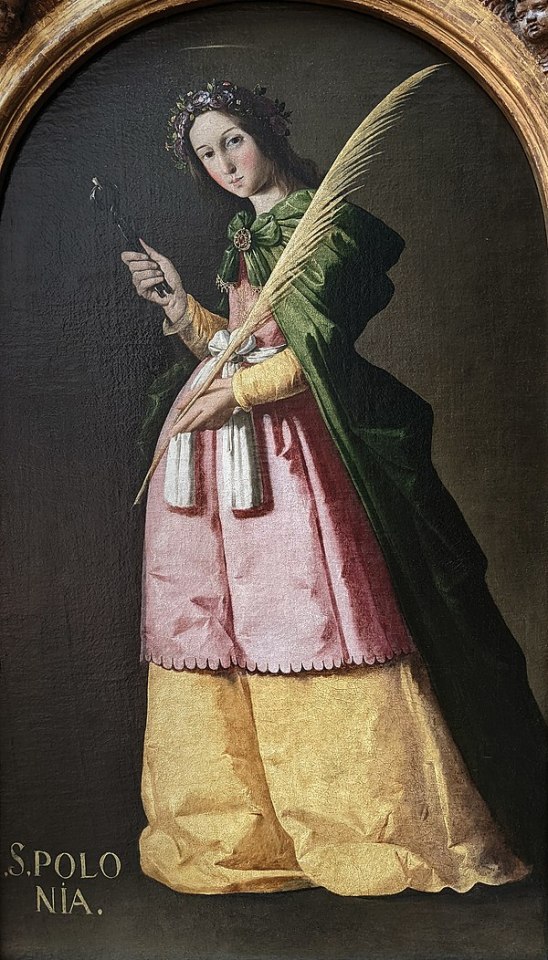
Francisco de Zurbarán (Spanish, 598-1654) Saint Apollonia ~ 1636 ~ Louvre
Renaissance artists had clothed their saints in classical draperies. Adopting to a certain extent the attitude of the Middle Ages, certain 17th century painters, such as Georges de La Tour, Zurbarán, and Caravaggio dressed them in the contemporary fashion. The natural mediators between God and the faithful are thus seen in a kind of mystical familiarity.
~ Wikipedia
#baroque master#art#painting#fine art#art history#women in paintings#spanish artist#baroque art#the louvre#francisco de zurbarán#religious art
14 notes
·
View notes
Text
reviews | collage | visual art | digital creations
𝐖𝐢𝐞𝐥𝐝𝐢𝐧𝐠 𝐭𝐡𝐞 𝐖𝐨𝐧𝐝𝐞𝐫𝐬 𝐨𝐟 𝐃𝐫𝐞𝐚𝐦𝐬 𝐚𝐧𝐝 𝐃𝐞𝐚𝐭𝐡
How the digital collage sensation ‘Welder Wings’ conjures up surrealist visions
.·:*¨༺ __________________
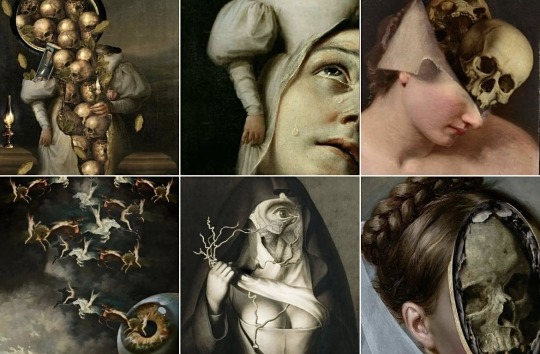
welderwings | Instagram
A tiny bit of fantastical absurdity – right in the palm of your hand. Type the name ‘Welder Wings’ (@welderwings) into your Instagram search bar and prepare to be consumed by deeply haunting works of art. The creations posted on the viral account seem to belong to a realm of nightmarish visions and chilling transformations: hordes of skulls are spilling out like rotten apples from half-hewn faces, parades of ponies are prancing in the sky while leaping out of enormous eyeballs, and human figures are mutating into hole-riddled vessels of sinister otherworldly souls. The world opening up in this little corner of the internet may perhaps not be for the faint-hearted. But it provides an undeniable thrill for all those drawn to the macabre.
Welder Wings is a passion project of the Spanish couple Francisco Abril and Nuria Velasco. The artist duo creates their Gothic-infused visuals through digital photo manipulation of Baroque or Romantic visual art. For example, THE INSENSATE BEAUTY (2024) is a bubbly execution scene in which Vigée Le Brun’s Marie Antoinette with a Rose (1783) suffers the same fate as her real-life counterpart. And in LAMENT OF MY STRANGLED HEART (2019), Caravaggio’s Judith (Judith Beheading Hologernes, 1602) gets her heart broken quite literally – through the gaping void replacing her face. Welder Wings’ works are subversive collages, transforming the serenity of the source material into scenes gruesome and grotesque.
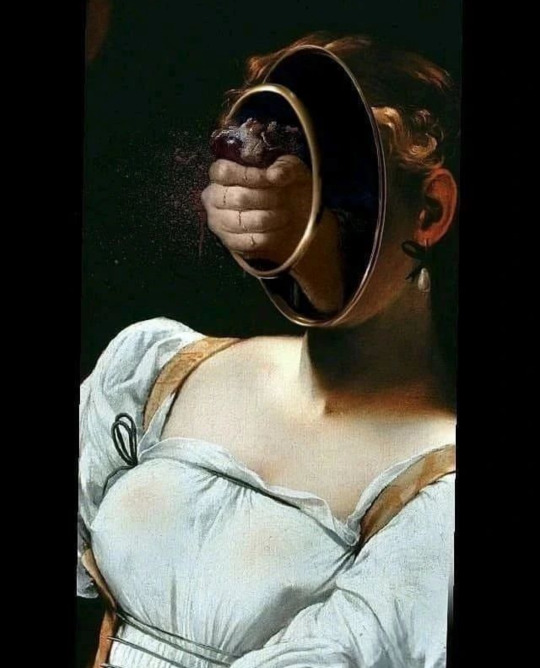
Welder Wings, LAMENT OF MY STRANGLED HEART (2019)
Abril and Velasco’s creations are undeniably surrealist. Their disruptive art forces us to plunge headfirst into the deep abyss of dreams and absurdity. Clearly, Welder Wings spreads its feathers decades after the official end of the 20th-century movement. But by making conscious references to surrealist artists and practices, the duo proves that its works are much more than digital forms of play. Rather, they are a proclamation of pastiche – a way to honor and continue the approach of their predecessors.
Form is Welder Wings’ most powerful tool. Although the works are careful to keep the aesthetic style of their source materials, evoking coherent looks of compositions in oil, they are the products of digital manipulation. With the power of image editing programs and the vast digital archive of visuals, the two artists have become architects of transfiguration. The collage has long been a method for surrealist visionaries. The juxtapositioning of pre-existing elements and resulting illogicality of images is a direct representation of the unfathomable, the unconscious, the unbelievable. For the Surrealist group, collages were delineations of dreams. And Welder Wings’ works certainly feel like dreams – terrible, terrifying dreams.

left: Welder Wings, WATER REFLECTION (2021), right: Dora Maar, Untitled (Shell Hand) (1934)
More than just understanding how to wield their predecessors’ weapons, Abril and Velasco do not shy away from directly quoting from the surrealist canon. If one takes the time to scroll through the account’s vastly-growing oeuvre, it becomes obvious just how much of its art integrates the movement’s achievements. The nature-claimed skeleton trees of DARK AUTUMN (2018) certainly could inhabit the same absurd landscapes that the likes of Salvador Dalí or Yves Tanguy have envisioned. Even more obvious of a reference is WATER REFLECTION (2021). The work pays a direct homage to Dora Maar’s Untitled (Shell Hand) (1934), a milestone of surrealist photomontage. The artist duo clearly extends a direct praise to those who came before them.
It is pleasurably disturbing to look at Welder Wings’ fantastical absurdity. The couple's collages are intricately-woven garments, fabrics stitched in order to become creations of dreams, delusions and death. By harnessing digital affordances and creating complex collages, the two artists maintain the avant-garde practices of the 20th-century Surrealist movement. Welder Wings’ has an undeniable awareness about the artistic past it has inherited – and it is not reluctant to credit it.
__________________ ༻¨*:·.
#surrealism#surrealist art#surrealist painting#collage art#contemporary art#digital collage#gothic aesthetic#review#art review#welder wings#instagram artist#thechimerasreviews
2 notes
·
View notes
Text
Muse: The band who fell to earth
Music journalist Simon Price talks to Muse ahead of their 2004 Glastonbury headline set, for The Independent. Sunday, 20 June, 2004. From the archives.
Good news! It's been a while since a group arrived fully formed from outer space. But here they are, primed and ready to storm Glastonbury, phase-shifters set to stun. Simon Price hits the road to Rome with neo-prog-rockers Muse, to reflect on the plenitude of old buildings, onrushing stardom and the place of guitar overload in the music of J S Bach.
Rome is a city where the present tarantellas chaotically with the ancient past, a surreal, anachronistic jumble of 20th-century, Renaissance and first-century architecture. Turn one corner and you're in La Dolce Vita, another and you're in Caravaggio, another and you're in Gladiator.
Rome is a city where the present tarantellas chaotically with the ancient past, a surreal, anachronistic jumble of 20th-century, Renaissance and first-century architecture. Turn one corner and you're in La Dolce Vita, another and you're in Caravaggio, another and you're in Gladiator.
In the heatlamp-intense glare of the afternoon sun, Muse do not especially resemble intrepid, Icarus-like rock visionaries whose musical ambition knows no restraint. If anything, in their brightly coloured Diesel shirts and three-quarter-length trousers, they look like anonymous, carefree Inter-railers seeing the sights.
The locals, however, are not fooled. As Matt Bellamy (vocals, guitar, piano), Chris Wolstenholme (bass) and Dom Howard (drums) laze by the Fontana di Trevi, where Anita Ekberg frolicked so iconically, or stroll down the Spanish Steps (until they are shooed away by a rather camp sailors' parade), they are regularly accosted by thrilled Italians asking for photos and autographs.
Bellamy, Wolstenholme and Howard all arrived in the sleepy Devon resort of Teignmouth from other parts of England. Instant outsiders, they bonded, and spent their teens getting into mild mischief, sneaking into the Single Parents Club in Winterbourne on Mondays and Tuesdays, hanging around in Poole drinking cider and playing football, and getting their heads kicked in for having long hair. "We were 14," Bellamy recalls, "and Howard was getting beaten up by 25-year-old men. It was that kind of place." Music was mainly a means to an end. Bellamy, whose father, George, played guitar in the Sixties instrumental group The Tornadoes studied the clarinet from the age of nine and had dreams of becoming a serious jazz musician. That all changed at the age of 13, when he played a Ray Charles blues piece on the piano at a talent contest. "I somehow pulled a girl, and I realised that music was a way to get female attention."
The three future Musos all joined various bands. "Dom's band was the cool one," Bellamy concedes. "They'd rent out a leisure centre, and all the kids would go to their gigs, smoke cannabis and so on." Things became a little more serious when the trio formed their own band. After working through names like Carnage Mayhem, Gothic Plague, Fixed Penalty and Rocket Baby Dolls, and frustratingly finding themselves obliged to play cover versions, they wisely settled on Muse.
With the invaluable help of the techno wizard Tom Kirk - the band's unofficial fourth member who drove them to London for their first gig in the capital, designs their live visuals and keeps a video diary of all they do - Muse were ready for take-off.
After attracting much attention at the 1998 In The City seminar in Manchester, the trio were invited to play similar showcases in New York and Los Angeles, winning record deals with Madonna's Maverick label in the States and Mushroom in the UK.
Their debut EP, Muscle Museum, and album Showbiz, produced by John Leckie(who also produced Radiohead's The Bends), won them a following from the kind of angsty teens who were already listening to bands like Placebo and the Manics, but sceptics dismissed them as a bunch of whiny sub-Radiohead wannabes. I should know. I was one of those sceptics.
For me, it all began to change with the release of "Plug In Baby", a single which sounded like a hotwired hybrid of Air's "Sexy Boy" and JS Bach's Toccata and Fugue, and the second album, the awkwardly titled Origin of Symmetry, in which they perfected a baroque'n'roll sound which combined operatic vocals with quasi-classical keyboards, Hendrix-like guitar overload, and at some points, church organs.
Muse were burning the punk rulebook. They were fearlessly resurrecting the banished ghosts of prog rock, and making music which was unashamedly pompous, histrionic and skyscrapingly ambitious. It was, in their phrase, hyper music.
At first I couldn't handle it. Slowly, I learned to love it. The clincher was their undeniably exciting live show, as encapsulated by their extraordinary appearance on this year's Brit Awards with which, to the minds of many viewers, they stole the show from that night's big winners, The Darkness. I ask if they have been aware of the way in which perceptions towards them have changed.
Howard is impish and smiley; Wolstenholme is the strong silent type; Bellamy is thoughtful and intense. Invariably, it is he who answers first.
"In the beginning," he says in the cool of the dressing room of the Stadio Centrale Del Tennis, "it was because we were young, and people thought we were just following in the footsteps of other bands." (He's right, of course. And some of those bands have been less than gracious about it. At this year's NME Awards, Thom Yorke - accepting the gong for Best Video - sneered: "We were up against some stiff competition there... what a shame Muse didn't win!")
Bellamy adds: "I think we've always been seen as an alternative band by which I mean that we're a band that has never really had its time. We've always been outside of all those. When nu-metal was big, we used to be seen in the same bracket as Coldplay, Radiohead, Travis. Now we're seen as quite rockin' - or maybe to the retro scene. What we've become alternative to has changed."
Muse now play with the assurance of a band who know that their pyrotechnics, both aural and visual, can win over pretty much any crowd. "We played a metal festival in Portugal the other day, and we were pretty nervous because the line-up was Korn, Static X, Linkin Park, and we were the only band who weren't pure metal. But we ended up going down really well. We can just about get away with playing to a metal audience without getting bottled off."
They've recently enjoyed playing to smaller, 500- to 1,800-seat venues in the United States, where the absence of the regimentation which their full visual extravaganza necessitates allowed them to play a more spontaneous, improvised set. But Muse aren't the sort of band who fetishise dingy, smoky club gigs - they're in their element playing to the masses.
Next Sunday, Muse headline the Pyramid Stage at the Glastonbury Festival. I put it to them that it's a special challenge, since they will be playing to a crowd who aren't there to see them, and indeed who bought their tickets before the line-up was announced. There's a certain pressure to unify and to entertain.
Wolstenholme is sceptical. "Sometimes it's easy to big-up certain festivals, like Glastonbury and Reading, because they were the ones we went to when we were kids. But when you've played loads of other European festivals, you look at it just like any other. But at the same time," he ponders, "it is Glastonbury..."
"Sometimes it's enjoyable," says Howard, "when you know people haven't seen you before. We do know that there will be a lot of people who aren't there to see us..." "Unless it rains," says Bellamy, "in which case they'll all go home except 4,000 Muse fans standing around in their wellies."
Ludicrous. Preposterous. Ridiculous. Absurd. Flick through any random pile of Muse press cuttings, and these words will crop up time and again. Can the band, I wonder, see where this sort of appraisal is coming from? "I think I could," Bellamy admits, "until The Darkness came along. And we had to let them take over. There was a bit of Queen in what we did, a bit of pompous rock, but now they've come along and shown people what that really is like." Listening to The Origin of Symmetry, and it's even more grandiose successor Absolution, I imagine Muse in the studio having debates on whether they can really get away with so many excessive pomp-rock flourishes.
"You'll often turn around," says Howard, addressing Bellamy, "and go: 'We can't get away with this!' And I'll go: 'Of course we can!'" I get the impression that Yes We Can invariably wins... "Definitely," confirms Wolstenholme. "There have been times when we listen to what we've done, and we've forgotten what we set out to do in the first place. And those usually are the best tracks on the album. Like 'Butterflies And Hurricanes', with those 48-track backing vocals..." "We had so many different scene changes," remembers Bellamy. "At one point there were bongos! It sounded like that percussion troupe Stomp. It sounded like that."
Yesterday, I tell them, I watched Ronald Reagan's funeral on CNN in my hotel room. The church organist played a crashing, portentous chord which reminded me of something I'd heard recently, and which made me laugh when I remembered what it was: the final note of "Megalomania" by Muse. "I can see why people are amused by it," Bellamy smiles. "It's music you can't listen to every day. If someone put it on in the background of a party, everyone would go: 'Fucking hell, turn it off!' Our music is definitely not for all occasions."
Muse's latest video, for "Sing For Absolution", is another example of the Yes We Can spirit. Most bands would baulk at a treatment which had them blasting into space on a futuristic shuttle, crashing through a meteor storm, and come skidding to Earth which, in a Planet Of The Apes-like twist, turns out to be in ruins. Muse, however, thought...
"Yeah, why not! Exactly!" Howard says. "We thought: 'Let's fly some spaceships around!'" "Something happened in the early Nineties," theorises Bellamy, "where bands started taking themselves very seriously... No, 'seriously' isn't the right word, but being very anti-everything."
There's always been an idea that "alternativeness" is about sullen refusal, about what you say "No" to. It dates right back to The Clash refusing to play Top Of The Pops. "We do say 'No' to a whole lot of stuff - teenage magazines, certain TV shows we try to shy away from... but the chance to wear a space suit? We're well up for that."
There's a famous Smiths story about Johnny Marr presenting Morrissey with what he considered to be his finest piece of music. Morrissey took it away, and came back with the lyric: "Some girls are bigger than others/ Some girls' mothers are bigger than other girls' mothers." Marr reportedly wept. When Muse have created a similarly epic piece of music, does Bellamy feel an obligation to match it with lyrics of sufficient solemnity and import? "That can be dangerous sometimes when music is written by one person and lyrics by another. But when I write something epic, I feel I have to match it, sure." Lyrically, Muse have improved noticeably since Showbiz. Gone are the vague abstractions and, while they're never completely specific either, their songs now express a similar pre-apocalyptic dread to Joy Division and The Specials in their era, or Tricky and (yes) Radiohead in theirs. "I think I'm trying to write something that genuinely means something and has a purpose," Bellamy says, "whereas in the past maybe it was vague lines strung together, abstractly. You had to read it a line at a time, and the lines never matched up.
"I've never been that confident writing lyrics," he confesses. "I've always had to do it behind the mask of a melody. I wish I could write lyrics like Tom Waits, where it's full-on stories... But as you get older, you become more open to singing things you would have said no to. I wouldn't sing lyrics like 'You've got to be the best' when I was 17 or 18, because I would have thought it wasn't very cool, and a bit cheesy to sing that hook. But you get towards your mid-twenties..." Once upon a time, Muse were typical tour-bus shut-ins. No more.
"I think something happened about two or three years ago," says Wolstenholme, "where we realised we'd been to so many cities of the world, and never really seen any of them. People come up to you and say: 'Oh, you've been there, what's it like?' and you can't tell them anything." Apart from "nice air-conditioning". "Exactly. So we've been making more of an effort to get out there and take it all in."
"Now we're playing larger venues, though, it's more difficult," Bellamy adds. "Smaller venues tend to be in the town, so you step outside and you're there. Larger venues tend to be out-of-town, so you step outside and you're in... the car park. Before you know it, you've been in five car parks in five countries. So we did a bit of wine-tasting in France, went to a temple in Kyoto in Japan, did a bit of beach surfing in Australia."
"We're just trying to turn the whole thing into a bit of a holiday," grins Howard.
"I had food last night," says Bellamy, "that actually brought me to tears (mass laughter). Home-made pasta with tomatoes. It was so simple, so perfect, so intense that I started to well up! It was so fucking good compared to England. In England, tomatoes just taste of water. And these tasted of pure tomato. I was starving at the time, obviously..."
The Stadio Centrale Del Tennis is part of the vast sporting complex built on the banks of the Tiber as a monument to Mussolini's vanity. On the main piazza, a towering obelisk bears the dictator's surname, with floor tiles spelling out "DUCE DUCE DUCE", and huge blocks of stone carrying the inscription "Fascista". In Germany or Russia, they'd have torn down such an uncomfortable reminder. Not here.
But then, almost all of Rome's great monuments were built to flatter someone, whether Pope, emperor, God or gods. I ask Muse what they make of it all. "It sounds a silly thing to say," says Howard, "but everything's very old. We went to the Colosseum, but couldn't get inside 'cos the queue was so big. And I tried to go to the Vatican but they wouldn't let me in because I had shorts on. They were quite long shorts," he sulks, "they weren't Eighties running shorts... It's a shame, because I really wanted to see the Sistine Chapel."
It took Michelangelo many years to complete his great fresco. The intention was to inspire a sense of religious awe in the viewer. Can Muse identify with that kind of endeavour, to create something magnificent? I betray my question with a giveaway chuckle.
"You can always tell when journalists are trying to make you say something embarrassing," smiles Bellamy, "because they give it away by laughing." Howard is more willing to bite. "I do look at the Colosseum and think how many people and how much talent and how many years did it take to make that. I don't think people will be saying that about us in hundreds of years' time." You're so modest.
"In two thousand years' time," says Bellamy, "maybe The Beatles. But not Muse." But what about the idea of creating something purely for the glory of someone else, be they human or divine? Can you understand that? Bellamy, whose musical heroes include Debussy, Bach, Berlioz, Chopin, Rachmaninov, Liszt, Reich and Glass, thinks about this one.
"Most great composers," he agrees, "were originally making music for God. And painters. They weren't making it for money in those days, because most of them were already part of a relative upper-class. It wasn't as if you could achieve fame and fortune by doing it. Maybe by the days of Chopin, but I'm talking before that. And I think that enabled them to do something that was out of the ordinary. When someone's got that belief that they are actually in touch with God, I'm sure that brings out things which they would not have thought possible. In architecture, music and the arts, there's definitely an intelligence in the past which has gone missing. We think we're advanced now, but we've actually slipped behind."
One of the stand-out tracks on Absolution is titled "Thoughts Of A Dying Atheist". Did any members of Muse have religious upbringings? Bellamy: "No." Howard: "I got christened, but... y'know..." Wolstenholme: "No." So, will you die an atheist? "I don't know," says Bellamy. "I think it's impossible to. At the last moment you'd be going 'Please!'" If Bellamy doesn't believe in God - yet - then some of his other beliefs may raise eyebrows. He's an advocate of the theories of the writer Zechariah Sitchin, who believes that humans are the result of genetic experiments by visiting aliens.
"It's a logical explanation," Bellamy gamely maintains, untroubled by the possibility that I might be trying to stitch him up and paint him as a fruitcake.
"I think it carries weight. Evolution theory is the most widely renowned anti-religion, anti-creationist argument, but there is a loophole in it, the missing link between humans and apes, the lack of fossils. Evolution normally takes millions of years, but we seemed to advance in a very short period of time." He's in full flow now.
"In Sumerian times they calculated there were 12 planets, counting the sun and the moon - and the 12th planet is on an elliptical orbit, and every time it comes close to the earth, every 3,600 years, Biblical-level events happen. Sitchin takes it a step further, suggesting it's a self-sufficient geothermal planet - essentially a comet - with aliens on it, who experimented with chimpanzees to make us. Which explains the higher levels of thought, objectivity and so on. Our DNA is a mixture of alien and ape." Bellamy is an obsessive character. When he gets into something, he really gets into it. His current fixation is playing poker. He carries a pack of cards everywhere, and would dearly love to be on Channel 4's Late Night Poker.
"I go to a semi-legal poker club on Clerkenwell Road in London. They've found a loophole in the law where as long as you put all your money behind the counter and use chips, it's OK. I only play for small stakes, for fun. It's not really like gambling, it's not just chance: it's more advanced than just sticking your money on a roulette table. There is an element of strategy."
This, however, is about as vice-packed as things get. By rock musician standards, Muse are unusually polite, reserved young men. I only see Bellamy snap once, while he's enjoying a strawberry milkshake outside a pavement café. A corpulent, rude American woman takes an unsolicited photo of my hairdo, with a pig-like laugh, to Bellamy's disgust. "We're gonna take a picture of your arse!" he calls after her as she waddles away. They're not very rock'n'roll, as rock'n'rollers go.
"We should be dressed up like you, shouldn't we?" he jokes, eyeing my black plastic spikes. I know you went through a phase, I say. (Bellamy once sported a huge Judder Man hairdo himself.) "It comes and goes... We had a phase where we had a go," he admits, "at the full-on rock'n'roll life. It lasted about a year, then we got jaded." Nowadays the groupies are a thing of the past. Bellamy and Howard's girlfriends are here, as is Wolstenholme's wife (with whom he has three children).
"Sometimes you have the odd week where you're looking for parties, but the rest of the time you're taking it easy, relaxing on a beach." On stage, however, it's a different story. Bellamy is a man possessed. At a recent show in Atlanta, he somehow slashed his face open with the end of his guitar, leaving a laceration on his top lip which needed five stitches and must have left him looking like a gore-movie version of Moog from Will O' The Wisp.
"In your everyday life you can be reserved, but I think you become more open, comfortable, confident, relaxed on stage. The more crazy part inside gets exposed and you don't have to hide it all." Headlining one of the nights of the oddly titled Cornetto Free Music Festival (it's actually €37 to get in), Muse's intensity and energy effortlessly enraptures 6,000 Italians who know every word of every song in a language they do not understand. When he isn't pulling rock-god poses with his guitar, Bellamy leaps, Oz-like, behind a metal keyboard-pulpit known as "The Dalek", fronted by LEDs which light up every time he hits a note. It's brilliant, and it comes as little surprise to learn that Muse once considered incorporating a vampire act into the show.
Winding down backstage, and accepting with bemusement a visit from the Eighties pomp-rockers Marillion ("Who are they?" they whisper to me), Muse tell me what the future holds in store. I heard a rumour that they want to take their music into a rock-disco direction... "I think it's something we tried with 'Bliss'," says Bellamy. "I don't think we'll suddenly change genre. We may incorporate a bit of funk in there, maybe even samba... Another thing I'd like to do is take pieces of classical music, like Prokofiev, or the music from 2001: A Space Odyssey. I don't mean sample it, I mean a piece of music which goes in and out of that." Yes, he is serious. Yes, I asked. In the more immediate future, both Howard and Bellamy have started to take helicopter lessons.
"It all depends on how many hours you can do a year to maintain your licence. I've only had one lesson so far. I've always wanted to go in a helicopter, and only recently did we get to do it when we were in..." "Australia?" ventures Howard.
"No, it was the Grand Canyon. I've always been interested in flying anyway. It's the safest form of air transport." Yeah? "People think it would just drop like a stone if the engine failed, but it would just glide slowly down. The blades keep turning - the up-force keeps them spinning." Bellamy, it must be said, has something of a daredevil streak. When he isn't piloting choppers or swimming with sharks, he's being an amateur rocketeer.
"I've got a paraglider at home. It's a 50cc engine you put on your back, with a propeller on it." His eyes sparkle as he describes it. "You've got this enormous parachute, and you run down a hill to get you off the ground, then you switch the engine on. And you can stay in the air, for hours and hours and hours..." Few bands dare to fly as high as Muse. If you see them overhead, give them a wave.
#Muse band#Muse interviews#Matt Bellamy#Dom Howard#Chris Wolstenholme#Simon Price#Price is a good music journalist! I finished half of this rn but he does good interviews#music journalism#Glastonbury 2004#muse#muse band
7 notes
·
View notes
Photo
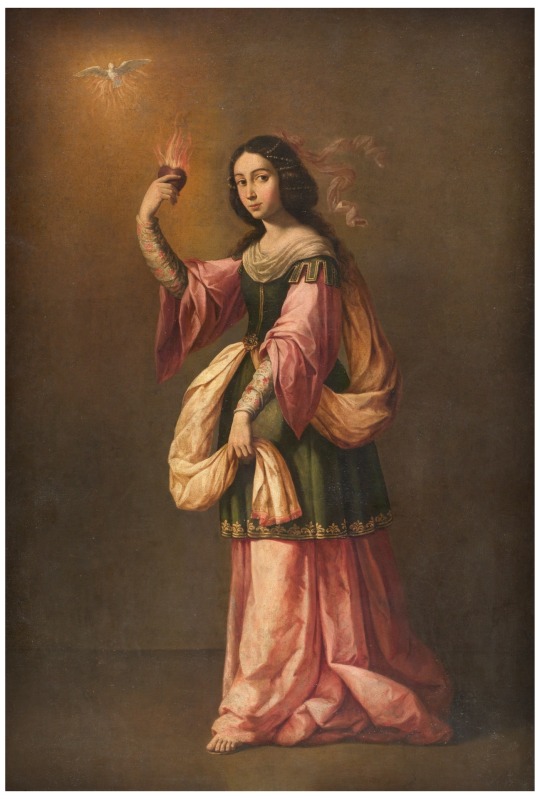

“Allegory Of Mercy”, 1655, by Francisco De Zurbarán (Spanish painter. He is known primarily for his religious paintings depicting monks, nuns, and martyrs, and for his still-lifes. Zurbarán gained the nickname “Spanish Caravaggio”, owing to the forceful use of chiaroscuro in which he excelled; Born: November 7, 1598, Fuente de Cantos, Spain - Died: August 27, 1664, Madrid, Spain).
3 notes
·
View notes
Photo
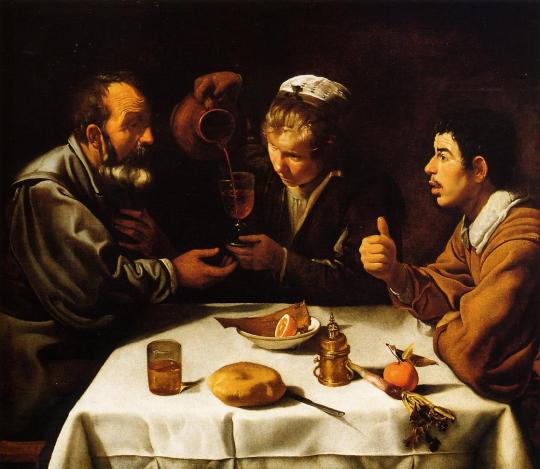
Diego Velázquez, Tavern Scene with Two Men and a Girl, ca. 1618-19, oil on canvas, 96 x 112 cm, Budapest Museum of Fine Arts.
“In this Tavern Scene and similar youthful bodegons (kitchen or tavern scenes named after the bodega, or inn) naturally the Spanish genius does not unfold in full maturity. Common folk populate the canvasses, in apparently banal situations, as if pages from the picaresque novels of Quevedo and his peers had come to life, where the larks of crafty servants and other villainous ruffians tickled the readers’ fancy. This startling naturalism often invited claims of Caravaggio’s influence, but at the time Velázquez had not even seen the pictures of the Italian vagabond. Even more importantly, in Velazquez there is no trace of Caravaggio’s violent coarseness, however vulgar the subject may be, and a kind of calm, puritanical solemnity vibrates in the air. We can only guess at the exact story behind the image, but whether we see them as scheming gaol-birds or characters from an ‘exemplary story’, the figures’ presence has weight and significance – no less so than the kings who populated the works of his mature period.”
3 notes
·
View notes
Text
"San Francisco en éxtasis" - Francisco de Zurbarán (c. 1640). Zurbarán (sometimes called the "Spanish Caravaggio") painted several versions of #SaintFrancis in meditation similar to this one.

#familiafranciscana#avemaria#hailmary#franciscanos#terciariosfranciscanos#franciscano#jesuschristo#sanfrancisco#terciariofranciscano
2 notes
·
View notes
Text
Top 20 Painters of All Time:
1. Leonardo da Vinci (1452–1519)
• An Italian polymath of the Renaissance, best known for his iconic works “Mona Lisa” and “The Last Supper.” Leonardo’s notebooks, filled with scientific diagrams, anatomical sketches, and artistic innovations, reveal his genius and insatiable curiosity.
2. Vincent van Gogh (1853–1890)
• A Dutch post-impressionist painter whose work, notable for its beauty, emotion, and color, highly influenced 20th-century art. He struggled with mental illness and remained largely unappreciated during his lifetime. “Starry Night” and “Sunflowers” are among his most famous works.
3. Pablo Picasso (1881–1973)
• A Spanish painter, sculptor, and one of the most influential artists of the 20th century. He co-founded the Cubist movement and is known for works like “Guernica” and “Les Demoiselles d’Avignon.”
4. Michelangelo Buonarroti (1475–1564)
• An Italian sculptor, painter, architect, and poet of the High Renaissance, celebrated for the painting of the Sistine Chapel ceiling and his sculpture “David.” His work is admired for its detailed portrayal of the human body.
5. Claude Monet (1840–1926)
• A French painter, a founder of French Impressionist painting, and the most consistent and prolific practitioner of the movement’s philosophy. His “Water Lilies” series is particularly famous.
6. Rembrandt van Rijn (1606–1669)
• A Dutch draughtsman, painter, and printmaker. Considered one of the greatest visual artists in the history of art and the most important in Dutch art history. His works include portraits, self-portraits, and biblical scenes.
7. Johannes Vermeer (1632–1675)
• A Dutch painter who specialized in domestic interior scenes of middle-class life. Vermeer was a moderately successful provincial genre painter in his lifetime but is now highly regarded for his precise compositions and use of light, notably in “Girl with a Pearl Earring.”
8. Salvador Dalí (1904–1989)
• A Spanish surrealist artist known for his striking and bizarre images. Dalí’s expansive artistic repertoire includes film, sculpture, and photography, in collaboration with a range of artists in a variety of media.
9. Frida Kahlo (1907–1954)
• A Mexican painter known for her many portraits, self-portraits, and works inspired by the nature and artifacts of Mexico. Her work has been celebrated internationally as emblematic of Mexican national and Indigenous traditions.
10. Georgia O’Keeffe (1887–1986)
• An American artist best known for her paintings of enlarged flowers, New York skyscrapers, and New Mexico landscapes. O’Keeffe has been recognized as the “Mother of American modernism.”
11. Jackson Pollock (1912–1956)
• An American painter and a major figure in the abstract expressionist movement. He was well known for his unique style of drip painting.
12. Edvard Munch (1863–1944)
• A Norwegian painter and printmaker whose intensely evocative treatment of psychological themes built upon some of the main tenets of late 19th-century Symbolism and greatly influenced German Expressionism in the early 20th century. His best-known work is “The Scream.”
13. Raphael (1483–1520)
• An Italian painter and architect of the High Renaissance. His work is admired for its clarity of form, ease of composition, and visual achievement of the Neoplatonic ideal of human grandeur. Known for “The School of Athens.”
14. Caravaggio (1571–1610)
• An Italian painter known for his realistic observation of the human state, both physical and emotional, which had a formative influence on Baroque painting. His use of dramatic lighting and realism was groundbreaking.
15. Titian (c. 1488/90–1576)
• An Italian painter, the most important member of the 16th-century Venetian school. He was recognized early in his own lifetime as a supremely talented painter, and his work was influential in defining the Venetian Renaissance.
16. Gustav Klimt (1862–1918)
• An Austrian symbolist painter and one of the most prominent members of the Vienna Secession movement. Klimt is noted for his paintings, murals, sketches, and other objets d’art. “The Kiss” (1907–1908) is his most famous work.
17. Hieronymus Bosch (c. 1450–1516)
• An Early Netherlandish painter known for his surreal, imaginative works depicting religious concepts, moral allegories, and narratives filled with fantastical creatures. “The Garden of Earthly Delights” is his most famous work.
18. Paul Cézanne (1839–1906)
• A French artist and Post-Impressionist painter whose work laid the foundations of the transition from the 19th-century conception of artistic endeavor to a new and radically different world of art in the 20th century.
19. Wassily Kandinsky (1866–1944)
• A Russian painter and art theorist credited with painting one of the first recognized purely abstract works. He believed that art could visually express musical compositions.
20. Andy Warhol (1928–1987)
• An American artist, film director, and producer who was a leading figure in the visual art movement known as pop art. His works explore the relationship between artistic expression, culture, and advertisement.
Each of these artists contributed uniquely to the fabric of art history, influencing not only their contemporaries but also countless artists and enthusiasts who followed.
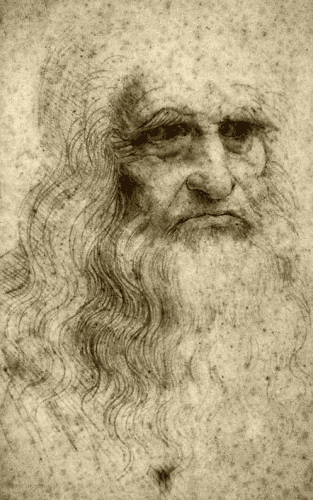
0 notes
Text
Day Trip to Rome: What Makes It Perfect for a Romantic Getaway?
Are you looking to escape with your loved one for a day trip filled with romance, history, and breathtaking views? Look no further than Rome! The eternal city offers a perfect setting for a romantic getaway, with its charming streets, iconic landmarks, and delicious cuisine. In this blog post, we will explore why a day trip Rome is the ideal choice for couples seeking a memorable experience together.
1. Historical Romance
A day trip to Rome is like stepping back in time to the days of ancient romance. From the majestic Colosseum to the romantic Trevi Fountain, every corner of the city is steeped in history and charm. Imagine strolling hand in hand with your partner through the ruins of the Roman Forum or sharing a kiss under the shadow of the Pantheon. Rome's historical sites provide the perfect backdrop for a romantic adventure.
2. Culinary Delights
No romantic getaway is complete without indulging in delicious food together. Rome is a food lover's paradise, with its mouthwatering pasta dishes, creamy gelato, and aromatic espresso. Treat your taste buds to a culinary journey through the city's trattorias and gelaterias, savouring each bite and creating lasting memories with your loved one.
3. Picturesque Views
Rome's skyline is dotted with picturesque views that are sure to take your breath away. Whether you're admiring the sunset from the Spanish Steps or gazing out over the city from the Gianicolo Hill, the panoramic vistas of Rome are perfect for capturing romantic moments with your partner. Don't forget to snap a selfie with the iconic St. Peter's Basilica in the background!
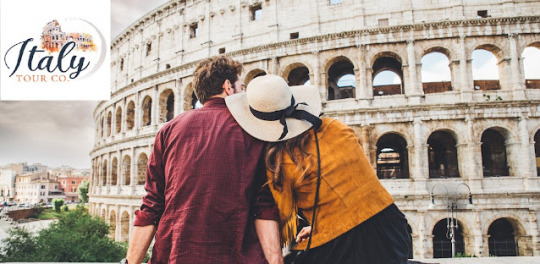
4. Romantic Walks
One of the best ways to experience Rome's romantic charm is by taking leisurely walks through its enchanting neighbourhoods. Lose yourselves in the winding streets of Trastevere, where ivy-clad buildings and cosy cafes create a cosy atmosphere perfect for romance. Or wander through the lush gardens of Villa Borghese hand in hand, enjoying each other's company in a peaceful setting.
5. Cultural Immersion
Immerse yourselves in Rome's vibrant culture by visiting its world-class museums, art galleries, and churches. Admire masterpieces by Michelangelo and Caravaggio at the Vatican Museums, or marvel at the beauty of the Sistine Chapel ceiling hand in hand. Explore the city's rich cultural heritage together and deepen your bond through shared experiences.
6. Romantic Gestures
Surprise your partner with romantic gestures that will make your day trip Rome even more special. Write love notes to each other and hide them in the pockets of your jackets, or plan a surprise picnic in one of the city's scenic parks. Small gestures of love and thoughtfulness will create lasting memories and strengthen your connection.
7. Sunset Romance
As the day draws to a close, savour the magic of Rome's sunsets with your partner by your side. Find a quiet spot along the Tiber River or atop the Aventine Hill, and watch as the sky transforms into a canvas of pink and gold hues. Hold each other close and revel in the beauty of the moment, knowing that you've shared a truly special day together.
Conclusion
In conclusion, a day trip Rome is the perfect choice for couples seeking a romantic getaway filled with history, culture, and unforgettable experiences. From its historical landmarks to its culinary delights and picturesque views, Rome offers a unique setting for love to blossom and memories to be made.
So why wait? Plan your day trip to Rome today and embark on a romantic adventure you'll never forget!
Source by - https://shorturl.at/fkU38
0 notes
Text
I'm thinking about something...
I'm clearly a sucker for light/dark academia, but I'm a 30 yo spoonie and I have other life projects than going back to uni, tbh. The only time school was satisfying, it was a woodworking class, and I couldn't graduate (chronic pain isn't compatible with spending 8 hours a day on a working table).
I have been grieving for the past years, but lately, I was hit by a wave of depression because of it, and I did my best to fight it, which made me think.
The only academic thing in my life, lately, is that I'm studying two languages (Spanish and Norwegian) on Duolingo. But also... I have a lot of books. Old books, art books, history books, poetry books, books in French, English, Spanish, even Norwegian. Old encyclopedias, from a different time, which give a very interesting vision of the world. I have access to the world's archive at the tip of my fingers.
I also have a nice apartment to myself. Why not combine the two ? I found a way to combine what I have and what I can never attain : cozy academia. Casually reading "Caravaggio by the details" while sipping tea, in the window nook, it's raining outside and I can watch that big old tree in the courtyard of the house on the other side of the river. I love this tree. Comfortably complete my 30 minutes of Duolingo on my couch with a cozy lofi compilation at a low volume. Reading the Complete Tales and Poems of Edgar Poe before bed, in a dim light. Watching a documentary while baking a pumpkin pie. Cozy academia ✨
1 note
·
View note
Text
Spectacular Art And Architecture You Must Explore In Rome
Rome is a city rich in history, culture, and art, and it's home to some of the world's most spectacular art and architecture. Here are some must-visit sites for art and architecture enthusiasts:
The Colosseum: This iconic amphitheater is one of Rome's most famous landmarks and a prime example of ancient Roman engineering and architecture. It's a must-visit for anyone interested in history and classical architecture.
The Roman Forum: Located near the Colosseum, the Roman Forum was the center of ancient Roman life. It's a sprawling archaeological site with numerous temples, arches, and other ruins that offer a glimpse into Rome's glorious past.
The Pantheon: This nearly 2,000-year-old temple is known for its perfectly preserved dome, which was a groundbreaking feat of engineering in its time. The interior is equally impressive, with a stunning oculus at its center.
The Vatican Museums: Home to one of the most extensive and impressive art collections in the world, the Vatican Museums are a treasure trove of paintings, sculptures, and historical artifacts. Don't forget to visit the Sistine Chapel, where you can admire Michelangelo's famous ceiling frescoes.
St. Peter's Basilica: Adjacent to the Vatican Museums, St. Peter's Basilica is one of the largest and most beautiful churches in the world. Its Renaissance and Baroque architecture, along with numerous sculptures and artworks, make it a masterpiece of art and architecture.
The Trevi Fountain: This Baroque masterpiece is not only a stunning work of art but also a popular spot for making wishes. Toss a coin into the fountain to ensure your return to Rome.
The Spanish Steps: Located in the heart of Rome, the Spanish Steps are a great example of Roman Baroque architecture. Climb the steps for a fantastic view of the city.
Borghese Gallery and Gardens: This museum houses an exceptional collection of art, including works by Bernini, Caravaggio, and Raphael. The surrounding Borghese Gardens are a beautiful place to stroll and relax.
Palatine Hill: This is one of the seven hills of Rome and is home to several ancient palaces, including the Flavian Palace. The ruins offer an excellent opportunity to explore Roman architecture and history.
The Baths of Caracalla: These ancient Roman baths are a testament to the grandeur of Roman architecture and engineering. The massive ruins give you a sense of the scale and opulence of Roman public buildings.
The Ara Pacis: This ancient altar, dedicated to Pax, the Roman goddess of peace, is a stunning example of Roman art and architecture. The altar is beautifully decorated with intricate reliefs.
Maxxi - National Museum of 21st Century Arts: If you're interested in contemporary art and architecture, the Maxxi museum designed by Zaha Hadid is a must-visit. It's a striking contrast to Rome's historic architecture.
Palazzo Barberini: This 17th-century palace houses the National Gallery of Ancient Art and features a magnificent frescoed ceiling by Pietro Cortona, making it a masterpiece of Baroque architecture and art.
Rome is a city that's almost like an open-air museum, where you can explore spectacular art and architecture around every corner. Whether you're interested in ancient Roman structures, Renaissance art, or modern architecture, Rome has something to offer every art and architecture enthusiast.
0 notes